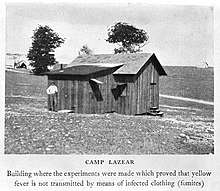Fomite
A fomes (pronounced /ˈfoʊmiːz/) or fomite (/ˈfoʊmaɪt/) is any inanimate object, that when contaminated with or exposed to infectious agents, such as pathogenic bacteria, viruses or fungi, can transfer disease to a new host.[1]

For humans, skin cells, hair, clothing, and bedding are common hospital sources of contamination of fomites.
Fomites are associated particularly with hospital-acquired infections (HAI), as they are possible routes to pass pathogens between patients. Stethoscopes and neckties are two such fomites associated with health care providers. Basic hospital equipment, such as IV drip tubes, catheters, and life support equipment, can also be carriers, when the pathogens form biofilms on the surfaces. Careful sterilization of such objects prevents cross-infection.
In addition to objects in hospital settings, other common fomites for humans are door knobs, light switches, handrails, elevator buttons, television remote controls, pens, and other items that are frequently touched by different people and that may be infrequently cleaned.
Researchers have discovered that smooth (non-porous) surfaces like door knobs transmit bacteria and viruses better than porous materials like paper money because porous, especially fibrous, materials absorb and trap the contagion, making it harder to contract through simple touch. Fomites include soiled clothes, towels, linens, handkerchiefs, cups, spoons, pencils, syringes, and surgical dressings.[2][3]
Etymology
The Italian scholar and physician Girolamo Fracastoro appears to have first used the Latin word fomes, meaning "tinder", in this sense in his essay on contagion, De Contagione et Contagiosis Morbis, published in 1546:[4] "By fomes I mean clothes, wooden objects, and things of that sort, which though not themselves corrupted can, nevertheless, preserve the original germs of the contagion and infect by means of these".[5]
English usage of fomes, pronounced /ˈfoʊmiːz/, is documented since 1658.[6] The English word fomite, which has been in use since 1859, is a back-formation from the plural fomites (originally borrowed from the Latin plural fōmĭtēs [ˈfoːmɪteːs] of fōmĕs [ˈfoːmɛs]).[7] The English-language pronunciation of fomites is /ˈfoʊmaɪts/, while the singular, fomite, is pronounced /ˈfoʊmaɪt/.[7][8][9]
In popular culture
Fomites play a conspicuous role in Steven Soderbergh's 2011 film Contagion about a pandemic.[10]
See also
References
- C, Dr. "Fomites, fomites, fomites! | Microblogology". Retrieved 2019-03-08.
- Abad, F. X.; R. M. Pintó; A. Bosch (October 1994). "Survival of enteric viruses on environmental fomites". Applied and Environmental Microbiology. 60 (10): 3704–10. PMC 201876. PMID 7986043.
- Pope, Theodore W.; Peter T. Ender; William K. Woelk; Michael A. Koroscil; Thomas M. Koroscil (December 2002). "Bacterial contamination of paper currency". Southern Medical Journal. 95 (12): 1408–10. doi:10.1097/00007611-200295120-00011. PMID 12597308.
- Nutton, Vivian (1990). "The Reception of Fracastoro's Theory of Contagion: The Seed That Fell among Thorns?". Osiris. University of Chicago Press. 2nd Series, Vol. 6, Renaissance Medical Learning: Evolution of a Tradition: 196–234. doi:10.1086/368701. JSTOR 301787.
- Fracastoro, Girolamo (1961). "Contagion, contagious diseases and their treatment (1546)". In Brock, Thomas D. (ed.). Milestones in Microbiology. Translated by Wright, Wilmer C. Prentice-Hall International. pp. 69–75. Retrieved 10 August 2013.
- "fomes". Oxford English Dictionary (3rd ed.). Oxford University Press. September 2005. (Subscription or UK public library membership required.)
- "fomite". Oxford English Dictionary (3rd ed.). Oxford University Press. September 2005. (Subscription or UK public library membership required.)
- "fomite". Merriam-Webster's Online Dictionary. Merriam-Webster.
- Discussion on Language Log, Mark Liberman, November 19, 2006
- Horn, John (8 September 2011). "Word of Mouth: 'Contagion' could really catch on". Los Angeles Times. Retrieved 12 August 2013.